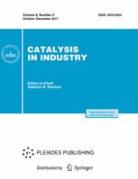Biotechnology for a new biodiesel
Abstract
A new biotechnology for biodiesel production based on filamentous fungi lipid was created. Oleogen Mucorales is used as a producer, forming up to 47–50 % lipid composition close to canola oil. The duration of fermentation process is 4–5 days at 27-28 °С. Biodiesel based on fungal lipid satisfies the requirements of European quality EN14214. The possibility is shown to increase the economic effects of biotechnology: 1) to create a waste-free technology by obtaining a single fermentation of biodiesel and chitin, 2) the use a stimulantsof germination of fungus conidia, which could reduce the duration of fermentation, and 3) the use of glycerol formed during the production of methyl esters, as a carbon source in the fermentation medium, as well as a number of food industry wastes and wood hydrolysates in the fermentation process.
About the Authors
Ya. E. SergeevaRussian Federation
L. A. Galanina
Russian Federation
V. V. Lunin
Russian Federation
E. P. Feofilova
Russian Federation
References
1. Liu B., Zhao Z.K. Biodisel production by direct methanolysis of oleaginous microbial biomass // Journal of Chemical Technology & Biotechnology. 2007. Vol. 82. № 8. P. 775– 780.
2. Li Q., Du W., Liu D. Perspectives of microbial oils for biodiesel production // Appl. Microbiol. Biotechnol. 2008. Vpl. 80. № 5. P. 749– 756.
3. D'Urso A., Bubbico R., Scarsella M., Bravi M. Fungal Biomass-Based Production of Lipids for Biodiesel Synthesis // Chem. Eng. Trans. 2008. Vol. 14. P. 251– 258.
4. Meng X., Yang J., Xu X. et al. Biodiesel production from oleaginous microorganisms // Renewable Energy. 2009. Vol. 34. № 1. P. 1-5.
5. Raposo S., Pardão J., Lima-Costa M.E. Oleaginous microorganisms as sustainable feedstock for biodiesel production // New Biotechnology. 2009. Vol. 25 (Suppl. 1). P. S276.
6. Vicente G., Bautista F. L., Rodríguez R. et al. Biodiesel production from biomass of an oleaginous fungus // Biochemical Engineering Journal. 2009. Vol. 48. № 1. P. 22-27.
7. Феофилова Е.П. Липиды мицелиальных грибов и перспективы развития олеобиотехнологии. II. Использование липидов грибов в биотехнологии // Биологические науки. 1991. №1. С. 5-26.
8. Kates M. Techniques in lipidology: isolation, analysis and identification of lipids. Second edition. Amsterdam: Elsevier Press. 1986.
9. Семенов В.Г., Зинченко А.А. Вычисление теплоты сгорания биотоплив по данным калориметрии и хроматографии // Химия и технология топлив и масел. 2006. № 6. С. 42-44.
10. Bamgboye A.I., Hansen A.C. Prediction of cetane number of biodiesel fuel from the fatty acid methyl ester (FAME) composition // Int. Agrophysics. 2008. Vol. 22. P. 21-29.
11. Сергеева Я.Э., Галанина Л.А., Андриянова Д.А. и др. Липиды мицелиальных грибов как альтернативный вид топлива для дизельного двигателя // Микробиология. 2008. Т. 44. № 5. С. 1-6.
12. Apendix B: Biodiesel Standarts // The Biodiesel Handbook / Eds. Knothe G., Gerpen J.V., Krahl J. Illinois: AOCS Press, 2005. P. 278-285.
13. The Lipid Handbook. / First edition Eds. Gunstone F. D., Harwood J. L., Padley F. B. London: Chapman and Hall., 1986.
14. Феофилова Е.П., Терёшина В.М., Меморская А.С. Хитин мицелиальных грибов: методы выделения, идентификации и физико-химические свойства // Микробиология. 1995. Т. 64. № 1. С. 27-31.
15. Феофилова Е.П., Терёшина В.М., Меморская А.С. и др. Новая отрасль биотехнологии – ранозаживляющие препараты на основе полиаминосахаров // Микробиология. 1999. Т. 68. № 6. С. 834-837.
Review
For citations:
Sergeeva Ya.E., Galanina L.A., Lunin V.V., Feofilova E.P. Biotechnology for a new biodiesel. Kataliz v promyshlennosti. 2010;(5):84-88. (In Russ.)




























